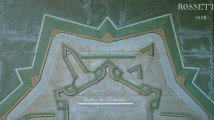Abstract
The treatises of Mohammad Abu’l-Wafa al-Buzjani (tenth c.) have influenced many architects, who utilized his innovative geometric principles and techniques in their works. The studies carried out thus far have focused on forms and have largely ignored the undergirding mathematical aspects. The present study aims to investigate the geometric principles used in the architectural works of Qavamuddin Shirazi, one of the architects of the Timurid period. Using selected problems from Abu’l-Wafa’s treatise, the plans of the Shirazi’s buildings are investigated by means of grid-based plan drawings, substituting the obtained numerical values in mathematical formulae, and adapting them to geometric problems. The analysis shows that Shirazi was aware of geometric problems presented by Abu’l-Wafa and the underlying mathematical principles, and that he tried to make use of specific geometries in his works.
























Similar content being viewed by others
References
al-Buzjani, Abu’l Wafa. Tenth century A.D. (A. Jazbi, Trans.). Tehran: Soroush, 2005.
Aqayani Chavoshi, J, Abu al-Wafa Buzjani, M, and Vitrak, B. (2011). Translation of the book Al-Najara (in practical geometry). Tehran - Iran: Written Heritage Research Center.
al-Farabi, M. 2010. Ahsa’a al-Ulum )science statistics(, H. Khadiwjam, trans.Tehran: Scientific Cultural Publication.
Golombek, Lisa. 1969. The Timurid Shrine at Gazur Gah. Royal Ontario Museum Occasional Paper 15. Toronto: Royal Ontario Museum.
Golombek, Lisa and Donald Newton Wilber. 1988. The Timurid architecture of Iran and Turan. Princeton monographs in art and archaeology, 46. Princeton: Princeton University Press. Farsi trans, M. Y. Kiani, trans., 1995 Tehran: Cultural Heritage Organization.
Hillenbrand, Robert. 1999. Islamic Art and Architecture. Thames and Hudson.
Hillenbrand, Robert. 2005. The Timurid Achievement in Architecture. In: A survey of Persian art from prehistoric time to the present XVIII, ed. A.Daneshvari, 235–245. Costa Mesa.
Kharazmi, M. 1989. Miftah al-Ulum (keys of sciences). Beirut: Dar Al-Kitab Al-Arabi.
Koliji, H. 2016. Gazing Geometries: Modes of Design Thinking in Pre-Modern Central Asia and Persian Architecture. Nexus Network Journal 18(1): 105-132.
Mahdiyar, M and Haji Ghasemi, K and others. 2000. Ganjnameh (cyclopeadia of iranian Islamic Architecture : theological school (volume5). Tehran: Shahid Behshti univercity.
Mahdiyar,M and Haji Ghasemi,K and others. 2004. Ganjnameh (cyclopeadia of iranian Islamic Architecture : Mosque (volume6). Tehran: Shahid Behshti univercity.
Man’kovskaia, L. Iu. 2017. A study of forms in Central Asian architecture at the end of the 14th century: the mausoleum of Khvāja Ahmed Yasawī. Iran: Journal of the British Institute of Persian Studies 23(1): 109–127. Farsi trans. A. Bahr al-Ulumi and B. Shirazi, trans., 1985.
Necipoğlu, Gülru. 1995. The Topkapı scroll: geometry and ornament in Islamic architecture (M. Qayyumi Bidhendi, Trans.). Tehran: Rozaneh Publishing, 2017.
Necipoğlu, Gülru.2017. The Arts of Ornamental Geometry: A Persian Compendium on Similar and Complementary Interlocking Figures. A Volume Commemorating Alpay Özdural. Muqarnas Supplements, Edited by Gülru Necipoğlu.
O’Kane, Bernard. 1976. The Madrasa Al-Ghiyā s īyya at Khargird. Iran: Journal of the British Institute of Persian Studies 14(1): 79–92.
O’Kane, Bernard. 1979. Tāybād, Turbat-i Jām and Timurid Vaulting. Iran: Journal of the British Institute of Persian Studies 17(1): 87–104.
O’Kane, Bernard. 1987. Timurid architecture in Khurasan. Mazda Pub. Frasi trans.: A. Akhshini, trans. Khorasan Razavi: Islamic Research Foundation of Astan Quds Razavi, 2007.
Özdural, Alpay. 2000. Mathematics and arts: Connections between theory and practice in the medieval Islamic world. Historia mathematica 27(2), 171-201.
Rokni, Noshad. 2014. Generosity letter and architectural board (Zij) from Qajar period in Malek National Library and Museum. Asar Scientific Quarterly.
Saliba, George. 1999. Artisans and mathematicians in medieval Islam. Journal of the American Oriental Society 119(4): 637-645.
Samarghandi, Dolatshah. 1959. Tazkarato al shoara, Mohammad Ramezani, trans. Tehran: Kalale Khavar.
Sarhangi, Reza. 2012. Persian Architecture and Mathematics: An Overview. Nexus Network Journal 14(2): 197-201.
Shahnavaz,Arash and Haji Ghasemi kambiz and others.2010. Ganjnameh (cyclopeadia of iranian Islamic Architecture : Mosque (volume12). Tehran: Shahid Behshti univercity.
Taheri, Jafar and Hadi Nadimi. 2012. Re-appraisal of the Legacy of Abū al-Wafā Būzjānī in Art and Architecture. Journal for the History of Science 10(2): 65-91.
Woepcke, Franz. (1855). Analyse et extraits d’un recueil de constructions géométriques par Aboûl Wafa. Journal asiatique 5th series, 5: 218-56, 309-59.
Yazdi, Sharaf al-Dīn. (2008). Zafarnāma (treatise of victory), S. Mir Mohammad Sadegh and Abdolhossein Navai, eds. Tehran: Islamic Consultative Assembly Library, Museum and Documentation Centre.
Author information
Authors and Affiliations
Corresponding author
Additional information
Publisher's Note
Springer Nature remains neutral with regard to jurisdictional claims in published maps and institutional affiliations.
About this article
Cite this article
Ebrahimi, A.N., Tooranpoor, M. Geometry and Mathematics in Timurid Architecture: Abu’l-Wafa and Shirazi. Nexus Netw J 24, 843–867 (2022). https://doi.org/10.1007/s00004-022-00612-0
Accepted:
Published:
Issue Date:
DOI: https://doi.org/10.1007/s00004-022-00612-0




